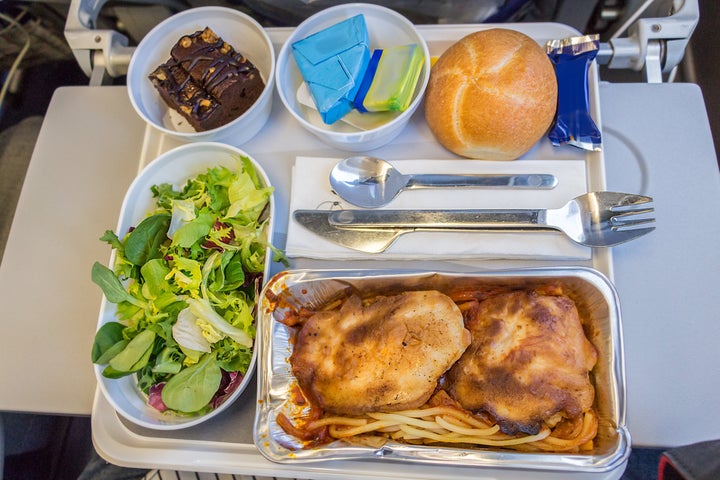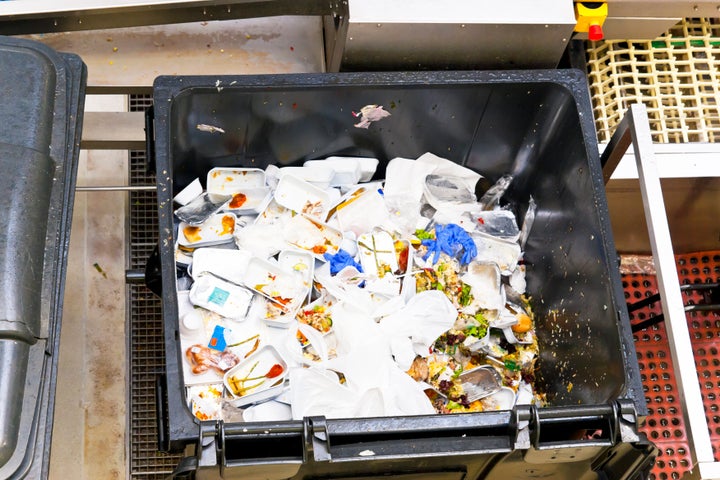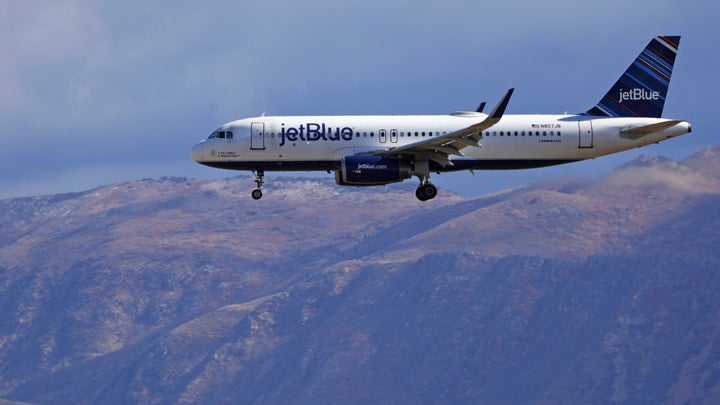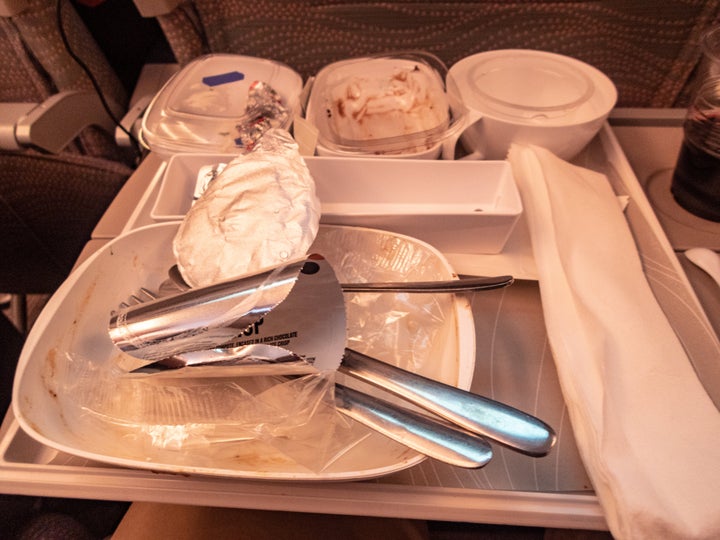Boarding a plane, you settle into a seat, perhaps pulling a blanket and pillow from plastic wrapping to get more comfortable. You take the flimsy plastic headphones offered by the flight attendant, accept some juice in a plastic bottle, with a plastic glass and stirrer, and settle in to pick at the in-flight meal, arranged in an assortment of plastic containers, using the plastic cutlery you’ve unwrapped from its plastic packet.
It’s a familiar scene for those who fly, especially on long-haul flights, and it’s a big environmental problem.
“The sheer amount of waste that comes from inside the planes is staggering,” says David (not his real name), a flight attendant for a regional carrier owned by American Airlines. “Plastic cups, cans and boxed juices, some of them opened and maybe one cup poured from them then thrown out, plastic wrappers for snacks, cocktail straws, napkins ... and none of it recycled,” he tells HuffPost. “This all comes on top of the environmental impact the flight alone has.”

As more people are becoming aware of aviation’s intensive carbon footprint ― it’s responsible for 2% of global human-caused carbon emissions ― a growing number have started to question whether they should be flying at all. The “flight shame” movement, bubbling up from the Nordic countries, is gaining strength across the world as it becomes more common for people to say they are cutting back on flying, with some quitting altogether.
But even as flygskam (Swedish for flight shame) becomes a recognizable term, global passenger numbers are not falling. Around 4.3 billion passengers flew in 2018, up 6.1% from the previous year, and around 4.5 billion passengers flew in 2019. Passenger numbers will nearly double by 2037, the International Air Transport Association (IATA) predicts.
And as more people fly, the sheer scale of the waste they produce on board is becoming its own environmental disaster.
In 2018, airlines generated around 6.7 million tons of cabin waste according to IATA. A study at London’s Heathrow Airport in 2012 and 2013 found the average passenger generated 3.1 pounds of waste across long- and short-haul flights.

Plastic is a big part of this waste stream, and a staggering problem globally. Only around 9% of the 6.3 billion metric tons of plastic waste we have produced has been recycled. Plastic waste pollutes our water, air and food, and has been found everywhere from the deepest parts of the ocean, to pristine mountain air, to a whale’s stomach.
There’s also food waste. Between 20% to 30% of the total waste is untouched food and drink, according to IATA. The remnants of a plane load of people’s unappetizing onboard meals pretty much always goes the same way as everything else: into the trash cart, destined for landfill or incineration.
“That’s the upsetting part about flying,” Megan Epler Wood, director of the International Sustainable Tourism Initiative at Harvard’s T.H. Chan School of Public Health, tells HuffPost ― appropriately enough from a layover in Miami. “They’re just throwing everything into one bag. And there’s no effort to separate, which means you know they’re not recycling because they can’t. Once the plastic or anything else becomes contaminated, it can’t be recycled.”
People often overlook the fact that waste is also a climate issue, says Epler Wood, pointing to the emissions it takes to produce the plastic, food and other items that end up as cabin waste. “All of that has actually not been factored in to the overall question of how much greenhouse gas is being emitted [when flying].”
“In training we asked about recycling and were laughed at.”
- David, a flight attendant
David says despite being an employee on the front line of this waste, even bringing it up with his employer is hard. “In training we asked about recycling and were laughed at, probably because of the pressure we have as flight attendants to turn these flights around so quickly. How do I have time to recycle when I have 27 minutes to get everyone off and the next flight boarded?”
Airlines are trying to make changes. But it’s slow.
Some airlines are taking steps to tackle the onboard waste problem. Australian carrier Qantas launched what it claimed was the first “zero waste” commercial flight in May 2019, between Sydney and Adelaide. All the waste produced onboard was either recycled, reused or composted. Plastic items were swapped out for reusable or compostable materials and stewards separated all the waste they collected.
In Europe, Air France has pledged to cut out 210 million pieces of plastic (such as cutlery, cups and drink stirrers) used on flights and to eliminate 1,300 tons of single-use plastics annually. Plastic products will be swapped out for alternatives including paper cups, bio-based cutlery and wooden stirrers. And, with European Union financing, Spanish airline Iberia co-launched the Zero Cabin Waste project aiming to recover 80% of the waste generated in flight cabins. As part of that, last May the airline brought in more than 500 trolleys with compartments to allow waste to be collected separately.
In the U.S., Alaska Airlines has pledged to reduce the in-flight waste per passenger going to landfill by 70% by 2020. On June 5, 2019, United Airlines flew what it called “the most eco-friendly commercial flight of its kind in the history of aviation,” which included zero cabin waste. And JetBlue has initiated an onboard recycling program to sort and recycle bottles and cans served on domestic flights.
A spokesperson for American Airlines, which owns the carrier David works for, told HuffPost it has had an aluminum recycling plan since 1989 and that “we have eliminated all plastic straws, instead offering a stir stick made of sustainable, environmentally friendly bamboo.” The airline says it’s currently looking for other cost-neutral biodegradable materials.

But many of the moves are slow and ad hoc, in no small part because plastic has the advantage of being both light and cheap.
There’s a strong demand from airlines for new materials, says Jon Godson, the assistant director for environment best practices at IATA, but finding them is far from simple.
London-based design company PriestmanGoode, which has been working with the aviation sector for two decades, has designed an economy meal tray out of edible, biodegradable and compostable materials such as coffee grounds, algae, bamboo and rice husk.
“The idea is to show that there are alternatives that we can explore,” Anna Meyer, the company’s head of communications, says of the concept design currently on display at the London Design Museum. But, she says, “the reality is there isn’t a simple solution, there isn’t a single material that can replace everything.”

It would be best not to have disposable items at all, says Godson, but materials like glass and metal cutlery, for example, are heavier, meaning a plane will burn more fuel and emit more carbon dioxide. They would also require washing which means detergents and possibly more pollution. “We want to ensure that the sustainability benefits [of any replacement materials] are proven,” Godson says.
It’s not just a problem for airlines to solve
To make a real difference, the systems also need to be in place for dealing with these waste flows, whatever the material. That means it’s not just about what happens on airplanes, but what happens at airports.
“It’s really up to the airports, because if the airlines have nowhere to put the waste, there is almost nothing they can do,” Epler Wood noted.
And it’s a very mixed bag when it comes to airports’ progress on waste. “San Francisco has done the best job,” she says. “They have a zero-waste policy that’s been in place longer than other airports and have the facilities in place to make sure they’re lowering the waste.” The airport aims to be the world’s first zero-waste airport by 2021. This will mean diverting 90% of waste from landfill and incineration by using materials that can be recycled or composted.
She also cites Hong Kong, which has pledged to be the greenest airport in the world. The airport has an on-site anaerobic food digester which can convert food waste to energy. It has also implemented a series of measures aimed at reducing cabin waste including conducting in-flight waste separation trials.
Regulation, however, can present a big obstacle. Some countries, especially those with a big agricultural sector including the U.S. and the U.K., treat waste coming in from international flights as hazardous and mandate that it be incinerated or buried deep in landfills. The aim is to prevent the spread of diseases affecting animals.
IATA has warned that without better regulation, cabin waste levels could double over the next decade.
“There’s a strong incentive for us to reduce the waste in the first place,” says Godson. “I think that’s critical. But when it comes to reuse and recycling, then we smack straight into animal health regulations around the world.” It’s often easiest to classify everything on the flight as hazardous, he adds.
“We’ve seen many airlines that have replaced single-use plastics, with more sustainable solutions such as bamboo, paper, cardboard cutlery, the whole variety of different biodegradable options, only to see that material incinerated on landing.”

Individuals can reduce their waste — but we can’t solve this crisis
Is there anything can individuals do? We can bring reusable water bottles, coffee cups and even utensils with us. IATA recommends not putting waste in seat pockets, refusing food and beverages you know you don’t want and pre-ordering meals when possible.
David even had one passenger who took her own bottles off the plane so she could recycle them ― but, he says, she is very much in the minority. “When people come on those planes, they do not think about the trash that they generate, and when you look at the conditions the cabin is left in when people get off the plane … trash is all over the floor, shoved into the pockets, and they don’t think about it.”
There’s plenty of academic evidence that people who recycle at home don’t even think to do it when they travel, says Epler Wood. “And I see that all the time … even with what I would call highly enlightened citizens.”
Regardless, individual actions can’t solve what is a systemic problem requiring systemic answers. “We’re stuck in a system where we are going to take the aircraft that suits our needs for our particular trip. And we’re going to use the airport that we need to use,” says Epler Wood.
David says, as things are, he feels powerless and desperately hopes that if more people are aware of the problem of cabin waste, airlines might be pushed to do more.
“Planes are not going away, and taking a flight is one of the largest contributors to a person’s carbon footprint. Recycling and reducing the amount of plastics on the planes would help reduce that footprint for every passenger on board. I know it would help me feel a little less bad for just passing the trash along knowing it will just end up in a landfill.”
HuffPost’s “Work In Progress” series focuses on the impact of business on society and the environment and is funded by Porticus. It is part of the “This New World” series. All content is editorially independent, with no influence or input from Porticus. If you have an idea or tip for the editorial series, send an email to thisnewworld@huffpost.com.
